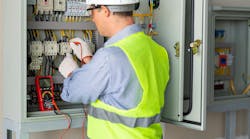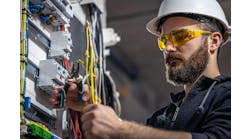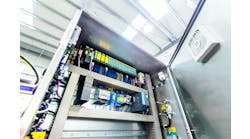How to diagnose noise issues in composite industrial electrical enclosures
Somewhere, at some point in my engineering past, I became the go-to person in my circle to troubleshoot electrical noise and grounding issues in automation lines. The symptoms of poor shielding and grounding can show up as a variety of hardware and even appear as software issues—I/O not behaving normally, drives faulting, controller logic issues and numerous other behaviors.
At that time, all of the electrical enclosures that I encountered were metal, usually steel, which made solving these issues somewhat straightforward, as grounding the cabinets and back panels and strapping them to ground could be facilitated by smartly connecting the grounding studs and panels to earth ground and/or to other cabinets in the line.
Get your subscription to Control Design’s daily newsletter.
As always, choosing the right electrical enclosure is crucial for ensuring the safety, functionality and longevity of equipment. Currently, though, a new set of materials is on the scene for enclosures. Composite materials, such as fiberglass, acrylonitrile butadiene styrene (ABS) plastics and recycled materials are becoming more mainstream and offer unique advantages for electrical enclosures, including resistance to corrosion, lightweight characteristics and ease of customization. However, prospective customers should also be aware of specific considerations related to electromagnetic interference (EMI) shielding and grounding schemes, which play a critical role in the effective operation of these enclosures.
Composite materials
Fiberglass enclosures are known for their durability and resistance to environmental factors such as moisture, chemicals and ultraviolet (UV) radiation. These enclosures are ideal for outdoor applications and harsh industrial environments. Their non-conductive nature also makes them suitable for applications where electrical insulation is critical.
ABS is a lightweight thermoplastic that offers excellent impact resistance and electrical insulation properties. ABS enclosures are often used in less demanding environments where aesthetic appeal and weight are the main considerations. However, they may not provide the same level of durability against harsh chemicals as fiberglass.
With increasing focus on sustainability, many manufacturers are turning to recycled materials for their enclosures. These materials can provide a balance of durability and environmental responsibility, appealing to companies looking to minimize their carbon footprint. However, the performance characteristics of recycled materials can vary widely, so it's crucial to verify their suitability for specific applications.
EMI shielding
Electromagnetic interference (EMI) can disrupt the operation of sensitive electronic equipment housed within industrial enclosures. EMI shielding is essential for maintaining signal integrity, especially in environments with heavy machinery or radio frequency (RF) sources.
When selecting a composite enclosure, consider the material’s inherent properties for EMI shielding. Fiberglass, while durable, often requires additional conductive coatings or meshes to provide effective shielding. On the other hand, ABS plastics typically have lower EMI shielding capabilities but can be enhanced through additives, such as carbon, or by integrating conductive liners.
Prospective customers should ensure that the enclosures comply with relevant EMI standards, such as IEEE 299 or MIL-STD-461. Requesting third-party testing data or certifications can provide assurance that the enclosure meets necessary performance criteria.
Grounding schemes for DIN rails and back panels
Grounding is another critical factor in the performance and safety of electrical enclosures. Proper grounding for cabinet structures like DIN rails (Deutsche Institut für Normung) and back panels are essential to prevent electrical hazards and ensure reliable operation.
DIN rails and back panels are commonly used for mounting electrical components such as circuit breakers, relays and controllers. It is essential to establish a reliable grounding connection to these components to prevent electrical faults. In composite enclosures, grounding can be achieved using metal grounding studs or bus bars attached to the DIN rail and internal panels. Ensure that these grounding points are accessible and that the grounding path is low-resistance to facilitate effective fault current dissipation.
Common grounding techniques
Star grounding is a technique that connects all components to a single grounding point, reducing ground loops and interference.
Single-point grounding, similar to star grounding, is an approach that ensures that all components share a common ground connection, effectively managing EMI.
Bonding ensures that all metal components within the enclosure are bonded together to create a continuous conductive path. This helps reduce the risk of electric shock and equipment failure.
When selecting composite industrial electrical enclosures, understanding the implications of EMI shielding and grounding schemes is vital for optimal performance and safety. Whether you choose fiberglass, ABS or recycled plastic materials, it’s essential to evaluate the specific needs of your application. By prioritizing effective shielding, robust grounding techniques and regular maintenance of the connections, you can ensure that your electrical systems can operate reliably and safely in even the most challenging environments. Always consult with manufacturers and industry experts to align your choices with best practices, standards and specific operational needs.
Ready to test your knowledge? Take this quiz to find out how well you know about electrical enclosures!





